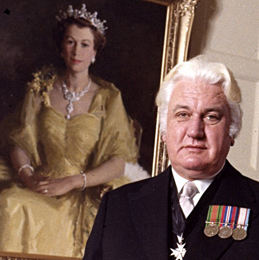Queen's Man: Australian Research Professor, Jenny Hocking, in her just published book, The Dismissal Dossier: Everything You Were Never Meant To Know About November 1975, alleges that Sir John Kerr was in contact with Queen Elizabeth II, her Private Secretary, Sir Martin Charteris, and Prince Charles, weeks before the final dismissal of the Whitlam Government. At no point, says Hocking, did any member of the Royal Family alert the Prime Minister of Australia that his country's democratically-elected government was about to be overthrown.
SCEPTICISM ABOUT THE EXISTANCE of the “Deep State” is very
strong in New Zealand. This country has been fortunate in avoiding the sort of
constitutional crises that bring the machinations of Deep State actors into
public view. Our neighbours across the Tasman have not been so fortunate.
It is almost exactly 40 years since the Governor General of
Australia, Sir John Kerr, sacked the government of Gough Whitlam’s Labour
Party. The “dismissal” of the Whitlam Government was long thought to be the
work of Kerr alone; a vice-regal intervention intended to resolve a
constitutional stalemate that was threatening to bring Australia to its knees.
This “official” version of events is now being challenged. In The
Dismissal Dossier: Everything You Were Never Meant To Know About November 1975,
Australian Research Professor, Jenny Hocking, makes it frighteningly clear that
Kerr had help.
One of the questions often asked by students of Whitlam’s
dismissal is: Why didn’t the Prime Minister simply pick up the phone and dial
Buckingham Palace? The Governor-General is, when all is said and done, merely
the monarch’s stand-in. Should he so forget his place as to seriously
contemplate dismissing a democratically re-elected government from office,
then, surely, a quick conversation between the Prime Minister and Her Majesty
would secure his instant removal from Government House and replacement by
somebody more committed to the democratic process.
According to Hocking, that most simple of solutions was
denied to Whitlam for the very simple reason that the Queen and her Private
Secretary, Sir Martin Charteris, were forewarned of the dismissal. Kerr had
taken the precaution of both writing and speaking to the Queen about what he
was planning to do well in advance of 11 November 1975. Indeed, the Queen’s
Private Secretary and the Governor-General had together run through the options
should Whitlam attempt to secure Kerr’s removal from office. In the event of
this “contingency”, Charteris informed Kerr, the Queen would “try to delay
things”.
Had Whitlam dialled Buckingham Palace, it is highly likely
that Charteris would have informed him that Her Majesty was indisposed and
unable to take his call.
At no time during the course of these alleged exchanges,
says Hocking, did the Palace think it appropriate to speak to the Prime
Minister of Australia about his Governor-General’s intentions. In such
circumstances it would have been very difficult for Kerr to interpret the
Palace’s silence as anything other than tacit support.
As if all this wasn’t bad enough, Hocking claims that, in
addition to the Queen, Kerr also discussed his plans to dismiss the
democratically-elected government of an independent Commonwealth nation with the
heir apparent to the British throne, Prince Charles. The latter’s alleged
response, if accurately reported by Hocking, raises serious questions about Charles’s
suitability as New Zealand’s next head of state.
According to Hocking, the Prince of Wales’ reply was: “But
surely, Sir John, the Queen should not have to accept advice that you should be
recalled at the very time should this happen when you were considering having
to dismiss the government.”
It seems that the Royal Family was not Kerr’s only source of
advice and support. The Governor-General is also said to have consulted senior
members of the Australian judiciary and, shockingly, the Liberal Leader of the
Opposition, Malcolm Fraser. Apparently, they, too, saw no reason to acquaint
the Prime Minister with the fact that Kerr was planning to overthrow the
Australian government.
There was another person in Australia who seemed to be
extraordinarily well-informed about the future of Whitlam’s government – Rupert
Murdoch. He had returned to Australia in the early months of 1975 peculiarly
confident that the Labour Government would be gone by Christmas. Accordingly, the
Murdoch-controlled press, well-informed by sources deep with the civil service,
waged an unrelenting campaign against Whitlam’s beleaguered ministry, and was
entirely supportive of the bloodless coup that toppled it.
Hocking’s accusations are, of course, political dynamite.
They call into question not only the constitutional reliability of the House of
Windsor, but all of Australia’s and the United Kingdom’s unelected power
structures – their Deep States. Australians also have cause to wonder about
their country’s relationship with the elected governments of the United
Kingdom. After all, how likely is it, if Hocking’s allegations are true, that
the Queen would have kept her own Prime Minister and his Cabinet in the dark about
Kerr’s intentions? Mind you, these were the years in which rumours of coups
against the Labour Government of Harold Wilson were rife. Was Her Majesty
advised that it might be wisest to keep Sir John Kerr’s intentions to herself?
Of course Hocking’s allegations, if wide of the mark, could
very easily be corrected by releasing all of the Palace’s 1975 communications
with Kerr. Unfortunately, these remain sealed under a 50 year suppression order
not set to expire until 2027. Even then it is most unlikely that they will be
released until all of the persons involved in the events of November 1975 are
deceased.
The Deep State does not like the light.
This essay was
originally posted on The Daily Blog
of Wednesday, 28 October 2015.

